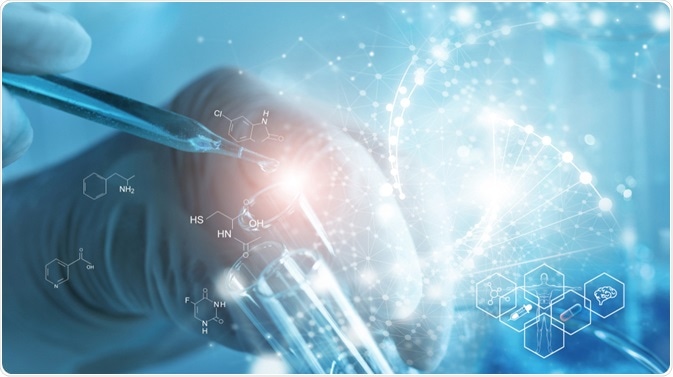While biochemistry is the study of chemical processes taking place within living organisms, biotechnology is the ultimate product of these discoveries, allowing the identified biochemical processes to be exploited for technological purposes, or better observed and analyzed in situ using biotechnical means.

Biochemistry. Image Credit: PopTika/Shutterstock.com
Biotechnology then includes the application of mechanisms uncovered within the field of biochemistry for the production of a useful product and the use of biochemical techniques in combination with physical analysis methods for a better understanding of biochemistry. For example, when utilizing a fluorescently tagged molecule in combination with a fluorescence microscope, allowing researchers to identify the precise target of a drug within a cell.
Biochemistry and biotechnology are therefore intricately linked, with an understanding of biochemical processes being required before they can be applied to technology, and once developed, technology may then subsequently allow for more biochemical discoveries to be made.
Biochemical technologies
The use of enzymes within the industry is a prominent example of a biochemical process that can be applied to biotechnology, potentially offering an environmentally friendly and highly efficient alternative to traditional chemical synthesis.
The first enzymes were described in the 19th century, and by the mid 20th century were already being utilized as catalysts for industrial applications such as the production of glycerol by the fermentation of yeast, or citric acid using the fungus Aspergillus niger. As researchers began to unravel the mechanisms behind the observed activity of enzymes a wider range of uses were found, one prominent example being the discovery of penicillin acylase, an enzyme found in some bacteria, yeast, and fungi that facilitates the production of several antibiotic precursors. It was also around this time that researchers began immobilizing the enzymes onto a solid substrate, allowing them to be recycled and reused without the high costs involved in the isolation and purification of large quantities of enzymes.
Advances in DNA technology subsequently allowed proteins of interest to be harvested in much greater numbers from bacteria or yeast, as the relevant DNA sequence could now be identified and inserted into a plasmid and highly expressed. The much wider availability of enzymes produced in this way further encouraged the adoption of biotechnical synthesis methods throughout the 1970s and 80s, with, for example, recombinant chymosin replacing that sourced from calf stomachs in the production of cheese.
Other advances in the field of biotechnology such as the development of polymerase chain reaction made it possible to generate large quantities of DNA, and by purposefully introducing errors to the copying process protein mutants could be generated and isolated. Selection of mutants bearing favorable qualities by humans followed by repeated error-prone PCR allowed the field of directed evolution to produce enzymes with much greater thermal and chemical stability, and when combined with the recombinant protein technology already developed, massively widened the useful application of enzymes in industry.
Case study: Lactose
As discussed, enzymes generally have greater specificity, lower energy thresholds, and better environmental stability than comparable synthetic chemical catalysts. One potential application of such enzymes is in the treatment of food waste, which is rich in carbohydrates, fats, and proteins that could potentially be recycled into other products such as biofuels.
Lactose is a major food waste product produced during yogurt manufacturing, being perceived as significantly less sweet than glucose by humans and therefore having less use within the food industry, besides concerns related to lactose intolerance. Enzymes are used to hydrolyze lactose into glucose, which can then be used in other food manufacturing processes.
More recently, lactose has been transformed into lactulose, a disaccharide prebiotic with suggested health benefits by immobilization of β-galactosidase onto a magnetic chitosan microsphere using a cellulose-binding domain. The enzyme is able to retain its activity over 20 cycles of use, which though impressive, still forces manufacturers to utilize lower-cost stationary phases.
Several enzyme immobilization methods have been developed that allow recovery and reuse, including flat solid supports and particulate supports, in the form of microbeads or nanoparticles, constructed from a wide range of materials with particular advantages and disadvantages. Researchers have noted a change in the activity of an enzyme depends on the support on which it is bound, with enzymes bound with nanoparticles, for example, exhibiting a negative correlation between nanoparticle diameter and activity in some cases.
The use of magnetic particles as described above allows the enzyme to be recovered using magnets, or particles constructed from heavier materials that can be recovered by centrifugation may be employed. In any case, a greater understanding of the biochemical processes taking place in any reaction, and how they may be influenced by factors intended to improve the efficiency of the process, will allow the biochemistry taking place to be applied to newly developing biotechnologies.
References:
Further Reading